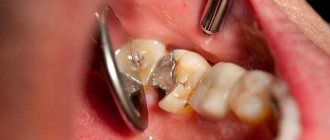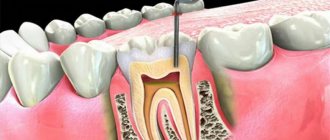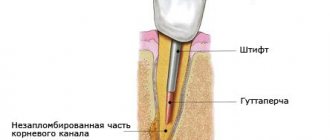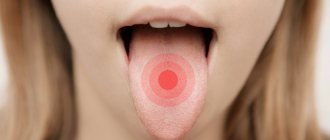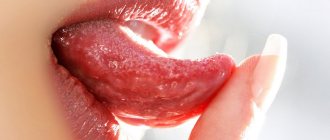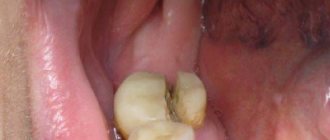Dental treatment is a medical procedure that corrects a smile, corrects imperfections and relieves pain. However, discomfort after dental surgery, in particular after installing a filling, does not go away immediately.
In 90% of cases, mild pain is natural, since the filling affects nerves, canals, and tissues. It takes time for the filling to “take root”. During this period, the pain can be constant, fading or variable, provoked by irritants: hot tea, strong pressure on the gums, etc.
But there are other pains - pathological ones. They require new medical intervention and careful treatment. Let's consider each option in more detail.
Questions and answers on: tooth hurts under a filling
The most common questions patients ask after tooth filling concern pain.
- Question : “A month ago, I had a tooth healed using paste to kill the nerve and installing a temporary filling, but it hurts when pressed. Also, the gums on the cheek side were swollen. After the temporary filling fell out, I did not install a new one. What to do? Is it related to the root or the nerves?” Answer : “Most likely, the periosteum became inflamed because the canals were not treated in time. It was necessary to treat them and put a permanent filling. In your case, the tooth needs to be removed, but if you consult a doctor urgently, there is a small chance of saving it.”
- Question : “Can a tooth hurt after filling? It’s been 2 hours since the filling was placed, but I feel a little pain.” Answer : “Mild pain in a filled tooth is a natural physiological reaction to surgical intervention in the dental cavity. Periodic painful sensations may be felt for 2 months until complete healing. They will pass unless the pain becomes more severe and increasing.”
- Question : “Yesterday we got a filling, but the tooth still hurts. A small rash and itching appeared near him. I can’t stand it any longer, what should I do?” Answer : “You need to see a doctor to replace the filling. You have developed an allergic reaction to it. This is quite a rare occurrence."
- Question : “A week ago I was treated for caries and a filling was placed at the 6th unit below. But the tooth did not stop hurting. It especially bothers me at night; I can’t sleep due to the throbbing pain. Should a tooth hurt after filling?” Answer : “Most likely, the dentist treated you for deep caries due to periodontitis or chronic pulpitis and made a mistake, guided only by a visual examination of the oral cavity. In any case, it was necessary to take an x-ray of the tooth affected by caries. We urgently need to remove the filling and treat the canals.”
- Question : “2 weeks ago a permanent filling was placed without removing the nerve, but it still hurts me to chew. In addition, the tooth reacts to cold and hot food and at times there is aching pain.” Answer : “Such symptoms may indicate the development of chronic pulpitis or the development of an abscess inside the tooth.”
If various pains appear in the tooth after the filling procedure, then the only recommendation is to contact a qualified specialist. After all, the reasons can be completely different.
What to do
In most cases, pain after filling gradually disappears on its own. However, you have to endure discomfort from one hour to several weeks. To reduce the unpleasant feeling you should:
- Regularly rinse your mouth with baking soda solution, herbal decoction or rinse;
- brush your teeth after every meal;
- for acute pain, take painkillers ;
- fever and inflammation can be eliminated with antibiotics, but with prior consultation with a doctor.
Tooth hurts after nerve removal and filling
Only a dentist after an examination will help you figure out why a tooth hurts after removing a nerve and filling its canals. Treating teeth on your own without a diagnosis is highly discouraged.
In dental practice, the procedure for treating tooth canals by removing a nerve is a rather complex manipulation. Cases of medical error are common. They are fraught with various complications, in which the filled tooth continues to hurt.
The main reason why a “dead tooth” (without a nerve) is bothersome is:
- removal of the filling material beyond the apex of the tooth - this occurs due to incorrect definition
- working tooth length;
- the doctor filled the canal incorrectly;
- a tool broke off in the canal;
- root perforation of the tooth;
- If your tooth aches, you may be allergic to the filling material.
It is worth considering that a tooth under a filling can hurt even without a nerve. After all, during the extraction procedure, only a small part of it is removed from the root canal, which branches off from the main nerve trunk. In addition, when removing and filling canals, dental tissues are damaged. When an anesthetic is applied to a tooth, pain is not felt; it begins to be felt after the anesthesia wears off. Such painful sensations are called post-filling.
After removal of a nerve, neighboring teeth can often be bothered, but it seems as if it is the treated tooth that is hurting. An experienced doctor will examine the dentition to identify and eliminate this problem. However, it is worth sounding the alarm when the nerve has been removed for a long time, and the tooth continues to hurt - this symptom may signal the development of chronic pulpitis or periodontitis.
In what cases is the nerve removed from a tooth?
First, let's look at why pulp removal (dental nerve) or depulpation is performed. The need for depulpation arises for several reasons. Practicing dentists identify the following indications for this operation:
- the occurrence of pulpitis: damage to the neurovascular bundle due to the spread of caries,
- extensive deep carious cavity: if the defect is more than 50% of the total volume of the crown, then a filling cannot be placed (it will not hold well and will quickly fall out), and other restoration options - pins, inlays, crowns - involve depulpation,
- the presence of several carious cavities: grinding down the enamel and removing infected dentin can significantly increase the size of the defect, i.e. again, the crown will have to be restored in such a way that pulp removal will have to be carried out,
- mechanical trauma: when a horizontal root crack is detected, for example, periodontitis: inflammation of the tissues of the ligamentous apparatus-1 surrounding the roots.
Tooth hurts after root canal filling
Dental clinic patients are often concerned about the question of why their tooth hurts after inserting filling material into the tooth canal after removal of the nerve. Since any intervention in the body has its consequences, toothache is an “echo” of the filling procedure.
The most common reasons for a tooth to ache after root canal filling are:
- burns and overdrying of dentin;
- allergic reaction to filling material;
- depressurization of the seal;
- change in bite;
- exposure to polymerization lamps;
- shrinkage of the filling.
After the procedure, the dentist usually advises you on how long the tooth under the filling hurts. However, if you feel increasing pain in a filled tooth for more than 2 weeks, you should urgently consult a doctor. Such pain can occur when an instrument breaks off in the canal, root perforation, or improper treatment of pulpitis.
Symptoms
The pain some time after the filling is installed has different variations, as it depends on the factors causing it. Unpleasant feelings when biting can be:
- Temporary or long-term.
- Immediately after treatment or a few hours later.
- With aching or acute manifestations.
The increase in sensitivity that occurs when pressing while chewing food is often caused by drying out the cleaned tooth cavity. In this situation, the nerve endings in the dentin are irritated.
Acute toothache (including throbbing) after completion of the filling process can be observed in case of inflammation of the pulp. The occurrence of pulpitis is caused by poor-quality treatment and unremoved remnants of the affected tissue.
Periodic pain often occurs in the chronic form of pulpitis. They are observed 2–3 days after filling. An aching pain is felt when pressing on the problematic tooth, and goes away immediately after the pressure on its surface is removed.
Options for relieving post-filling pain
If a tooth begins to hurt due to a filling being placed, but its condition does not require additional dental procedures to reduce the sharp pain, the doctor may prescribe:
- painkillers ; most often these are drugs from the group of non-steroidal anti-inflammatory drugs (NSAIDs); Ketoprofen (Ketonal) has the best analgesic properties; in case of severe pain, it is enough to take a long-acting capsule of 150 mg - these will relieve pain for a day; instead of Ketonal, you can use the rectal suppository Diclofenac - 100 mg; both drugs are contraindicated in the presence of a gastrointestinal ulcer; in such cases, it is better to take a nimesulide tablet (Nise) - it has almost no negative effect on the gastrointestinal tract;
- physiotherapeutic procedures - to reduce pain, electrophoresis with novocaine is prescribed; for swelling, it is better to use hydrocortisone instead of novocaine; Magnetic and laser therapy are also used; the number of procedures depends on the patient’s condition;
- a one-time injection of an antibiotic solution into the periodontal tissues - for problematic traumatic treatment to prevent infectious inflammation and pain.
There are many folk recipes for relieving severe post-filling toothache:
- rinsing the mouth with a decoction of oak bark; Pour 2 tablespoons of crushed bark into a glass of water, bring to a boil, boil for 15 minutes, add boiled water to the original volume, strain and rinse your mouth several times a day; when a tooth hurts, it relieves inflammation, swelling and associated pain well;
- applying a small piece of salted (but not smoked) lard to the gum - this application is especially helpful for pain associated with tissue swelling: salt draws fluid from the tissue, swelling and pain go away;
- a reflex method of pain relief (used in folk medicine for a very long time): grate a clove of garlic on a fine grater, place it in a thin napkin, apply it to the inside of the wrist of the hand opposite the painful tooth, fix it and leave it overnight.
Causes of depulpation
There are a number of indications for dental nerve removal. Depulpation is most often carried out in the following cases:
- with extensive carious lesions affecting the dental nerve;
- development of infection in the dental canal;
- mechanical damage to the pulp;
- In the process of preparing for prosthetics, even a healthy pulp may be removed; this is necessary to eliminate the risk of developing re-inflammation in the tooth after the installation of an orthopedic structure.
The procedure for removing pulp from a tooth is performed in the following sequence: 1. Based on an x-ray taken, the doctor determines the structure and size of the dental canals. 2. Local anesthesia is administered. 3. The pulp is removed first in the coronal and then in the root part of the tooth. 4. Dental canals without pulp are carefully treated with an antiseptic solution. 6. After treatment, the canals are sealed. 7. Most often, a temporary filling is subsequently placed on the tooth, which later must be replaced with a permanent one.
What complications may arise?
Poor treatment is likely to lead to complications, and these, in turn, are accompanied by pain, swelling and inflammation. Thus, due to incomplete canal filling, patients often develop periodontitis (inflammation of the periodontium), which, in turn, can cause cysts. They are not so easy to deal with, and over time, if not properly treated, these formations can lead to tooth loss.
It is important to know! Sometimes refilling the canals does not relieve discomfort. Even after a repeated procedure, some patients suffer from discomfort for a long time, and may even experience symptoms of neuralgia, a nerve disease characterized by attacks of sharp, severe pain.
The most serious complications result from canal perforation and root damage. If during the manipulations the dentist did any of the above, then without treatment the damaged tooth will not “last” very long - it will require removal. If the error is identified in time, there is a chance to correct the situation.
Often, after depulpation, a person discovers that the cheek next to the tooth is swollen. The swelling can be quite severe and is accompanied by an increase in body temperature and general malaise, which makes it difficult to eat and talk. If the symptoms are so severe, you should immediately contact a specialist to find out the cause of this reaction. The dentist will check to see if inflammation with suppuration has begun in the root area. Before going to the dentist's office, you should not heat the swollen area, and you should not sleep on that side of your face.
“Before pregnancy, I had a long trip to dentists. The front incisor, which had already been treated and re-treated more than once, began to hurt after pulpitis and ached periodically - sometimes strongly, sometimes weakly. And in the end I was so exhausted that I told the doctor I won’t leave until you cure it or tear it out already. It turned out that there were as many as 2 roots, and not just one, and for some reason an X-ray had not been taken before. It was in this additional root that there was a living nerve, because of which everything hurt. We treated it and everything became perfect.”
Ksyusha95, review from the woman.ru forum
A fistula or abscess on the gum next to the treated roots is another reason to visit the dentist. Most likely, an inflammatory process has begun in this place, and the appearance of an abscess is a clear sign of it. Touching or opening such a formation is strictly prohibited - you can cause an infection and aggravate the situation.
Poor cleaning of the cavity
In rare cases, when installing a tooth filling, a dentist may simply not notice microscopic areas of carious lesions in the tissues. Despite treating the area with antiseptic drugs, a small amount of pathogenic bacteria may still remain in the tissues of the carious cavity. This will lead to the fact that in a year or two, the enamel in this area will be destroyed and the tooth in which the filling will ache. Often, such processes can occur chronically, without showing any symptoms for years and without needing treatment, and then one day the tooth gives acute pain, indicating the onset of inflammation in the nerve tissues.
What to do if a dead tooth hurts
At the first appearance of pain, you should contact your dentist. Since in most cases pain is a consequence of the inflammatory process, the doctor must carry out a diagnosis.
It is imperative to assess the condition of the gums, diagnose (or exclude) diseases such as periodontal disease, periodontitis, etc. Gum disease is difficult to treat, and timely diagnosis will help to prescribe the right treatment in time.
After diagnosis, the doctor prescribes treatment aimed at eliminating the causes of pain:
- If inflammation is detected, anti-inflammatory drugs or antibiotics may be prescribed.
- The old filling is removed, the canals are cleaned, and the filling is performed again.
- The darkened crown of the dead tooth is additionally whitened to restore the aesthetics of the smile.
If you have a problem similar to that described in this article, be sure to contact our specialists. Don't diagnose yourself!
Why you should call us now:
- We will answer all your questions in 3 minutes
- Free consultation
- The average work experience of doctors is 12 years
- Convenient location of clinics
Single contact phone number: +7
Make an appointment
A specific treatment plan is prescribed individually, based on the results of the examination and the general condition of the patient’s teeth and gums. Sometimes pain in a dead tooth is a consequence of a whole range of dental problems.
Reaction to heat: is it possible?
There are cases when hot food or drinks cause pain in a pulpless tooth. Normally, this should not happen, because the doctor removed the pulp, which made the unit of the dentition insensitive to thermal influences.
However, if particles of nerve tissue remain inside, sensitivity may persist and cause discomfort. Another scenario: inflammation from the pulp has spread further, and exposure to hot foods or liquids causes pain in these tissues. To accurately determine the cause, you should contact a professional. X-rays and examination using a special microscope will help identify the source of residual sensitivity.
How to relieve pain at home
When discomfort bothers you after cleaning the root canals and installing permanent or temporary fillings, the discomfort can be relieved at home. Universal methods include:
- Warm rinses with a solution of soda or salt, or a combination of these ingredients.
- Decoctions of medicinal herbs (sage, oregano, chamomile, calendula, mint) help well. Their effect is calming. Procedures must be carried out at least 4-5 times a day.
- Apply a small piece of propolis to the sore spot, and rinse your mouth with the tincture of this bee product, adding half a teaspoon to a glass of water.
- Plantain leaves or roots are applied to the diseased unit.
- Lavender, St. John's wort, and clove oils are often used. They moisten a gauze swab and apply it to the sore spot.
- Drug therapy. We are talking about painkillers. Temporarily relieves pain by taking Nimesulide, Ketanov, Tempalgin, Naiza, Baralgin according to the instructions.
To prevent increased pain in the first two to three days:
- You should avoid cold, hot, sour, sweet foods, and eat only warm foods that do not irritate the tissue, especially if the incisors and molars are overly sensitive;
- Avoid hypothermia;
- Remove from the menu solid foods that need to be bitten into pieces;
- Do not load on the causal unit;
- Chew on the opposite side of the jaw;
- Regularly and thoroughly brush your teeth and maintain oral hygiene;
Remember that when taking medications that dull pain, do not increase the dosage yourself. After all, this way you can muffle unpleasant symptoms and disguise the true aspects of the pathology.


